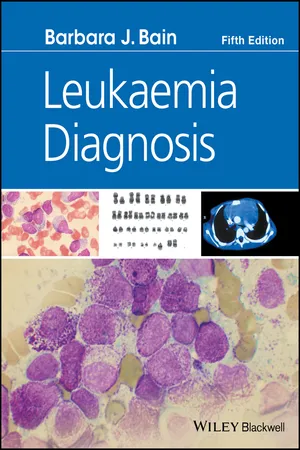
- English
- ePUB (mobile friendly)
- Available on iOS & Android
Leukaemia Diagnosis
About this book
From the bestselling author, Barbara J. Bain, the new edition of this practical reference on the principles of leukaemia diagnosis and classification has been fully updated, and incorporates the recently revised WHO classification.
Leukaemias are a very heterogeneous group of diseases, which differ from each other in aetiology, pathogenesis, prognosis and responsiveness to treatment. Accurate diagnosis and classification are vital for the identification of specific biological entities and underpin scientific advances in this field. The detailed characterization of haematological neoplasms is also essential for the optimal management of individual patients.
In this user-friendly guide, Professor Bain illustrates and explains how these many laboratory techniques are used for the diagnosis and classification of leukaemia and related disorders. Leukaemia Diagnosis, Fifth Edition will be highly valuable to trainee haematologists and laboratory scientists in haematology and related disciplines, and will also prove a useful reference source and teaching aid for those who already have expertise in this field. In addition, cytogeneticists and molecular geneticists will find that this book enhances their understanding of the relationship of their disciplines to the diagnosis, classification and monitoring of leukaemia and related disorders.
Essential reading for every haematologist and haematopathologist, Leukaemia Diagnosis, Fifth Edition features
- Over 300 high quality full colour digital images of abnormal cells in leukaemia and lymphoma supplemented by histological, cytogenetic and immunophenotyping images
- Recent information on cytogenetic and molecular genetic abnormalities in leukaemia
- Updated information on the characteristic immunophenotypic characteristics of different categories of leukaemia
Frequently asked questions
- Essential is ideal for learners and professionals who enjoy exploring a wide range of subjects. Access the Essential Library with 800,000+ trusted titles and best-sellers across business, personal growth, and the humanities. Includes unlimited reading time and Standard Read Aloud voice.
- Complete: Perfect for advanced learners and researchers needing full, unrestricted access. Unlock 1.4M+ books across hundreds of subjects, including academic and specialized titles. The Complete Plan also includes advanced features like Premium Read Aloud and Research Assistant.
Please note we cannot support devices running on iOS 13 and Android 7 or earlier. Learn more about using the app.
Information
1
The Nature of Leukaemia, Cytology, Cytochemistry and the Morphological Classification of Acute Leukaemia
CHAPTER MENU
- The nature of leukaemia
- The aetiology of leukaemia
- The importance of classification
- The nature and classification of acute leukaemia
- The nature and classification of the myelodysplastic syndromes
- The nature and classification of chronic myeloid leukaemias and myelodysplastic/myeloproliferative neoplasms
- The nature and classification of lymphoid neoplasms
- Defining a blast cell, a promyelocyte and a promonocyte
- The FAB classification of acute leukaemia
- Diagnosing acute leukaemia
- Distinguishing between acute myeloid and acute lymphoblastic leukaemias
- Defining remission
- The incidence of acute leukaemia
- The FAB categories and other morphological categories of acute myeloid leukaemia
- Acute myeloid leukaemia with minimal evidence of myeloid differentiation: M0 acute myeloid leukaemia
- Acute myeloid leukaemia without maturation: M1 acute myeloid leukaemia
- Acute myeloid leukaemia with maturation: M2 acute myeloid leukaemia
- Acute hypergranular promyelocytic leukaemia: M3 acute myeloid leukaemia
- The variant form of acute promyelocytic leukaemia: M3 variant acute myeloid leukaemia
- Acute myelomonocytic leukaemia: M4 acute myeloid leukaemia
- Acute monocytic/monoblastic leukaemia: M5 acute myeloid leukaemia
- Acute myeloid leukaemia with predominant erythroid differentiation: M6 acute myeloid leukaemia
- Acute megakaryoblastic leukaemia: M7 acute myeloid leukaemia
- Acute eosinophilic leukaemia
- Acute basophilic leukaemia
- Acute mast cell leukaemia
- Langerhans cell leukaemia
- Hypoplastic or hypocellular acute myeloid leukaemia
- Clinical correlates of FAB categories of acute myeloid leukaemia
- The FAB classification of acute lymphoblastic leukaemia
- ‘Acute lymphoblastic leukaemia’ of L3 subtype
- Automated full blood counts in acute leukaemia
- References
The nature of leukaemia
Table of contents
- Cover
- Title Page
- Table of Contents
- Preface
- Commonly Used Abbreviations
- 1 The Nature of Leukaemia, Cytology, Cytochemistry and the Morphological Classification of Acute Leukaemia
- 2 Immunophenotyping and Cytogenetic/Molecular Genetic Analysis
- 3 Acute Myeloid Leukaemia: Integration of Morphological, Immunophenotypic and Genetic Information and the WHO Classification
- 4 Acute Lymphoblastic Leukaemia and Acute Leukaemia of Ambiguous Lineage
- 5 The Myelodysplastic Syndromes and the Myelodysplastic/Myeloproliferative Neoplasms
- 6 Chronic Myeloid Leukaemias
- 7 Lymphoid Leukaemias of Mature B, T and Natural Killer Cells
- 8 Leukaemia Diagnosis in Resource‐Poor Countries
- Index
- End User License Agreement